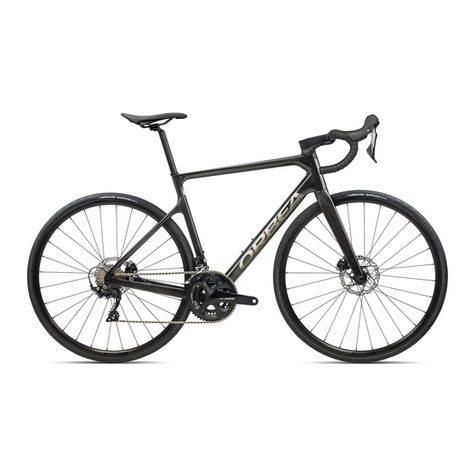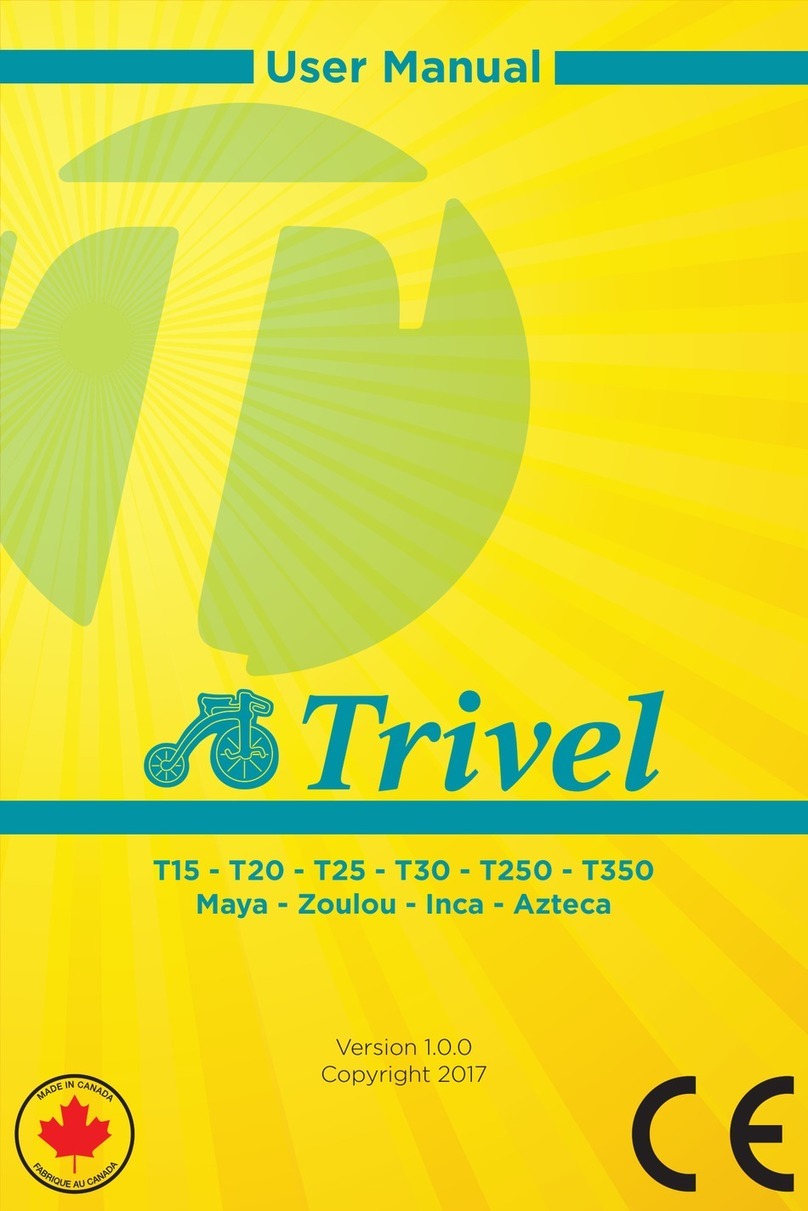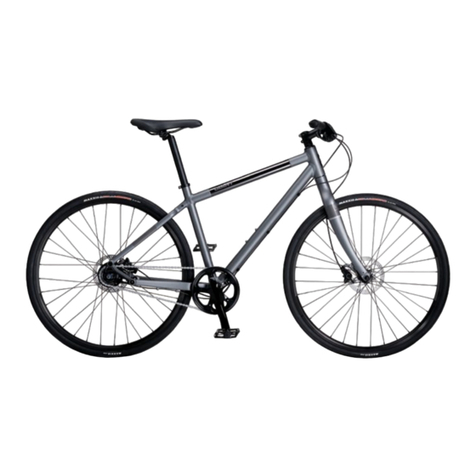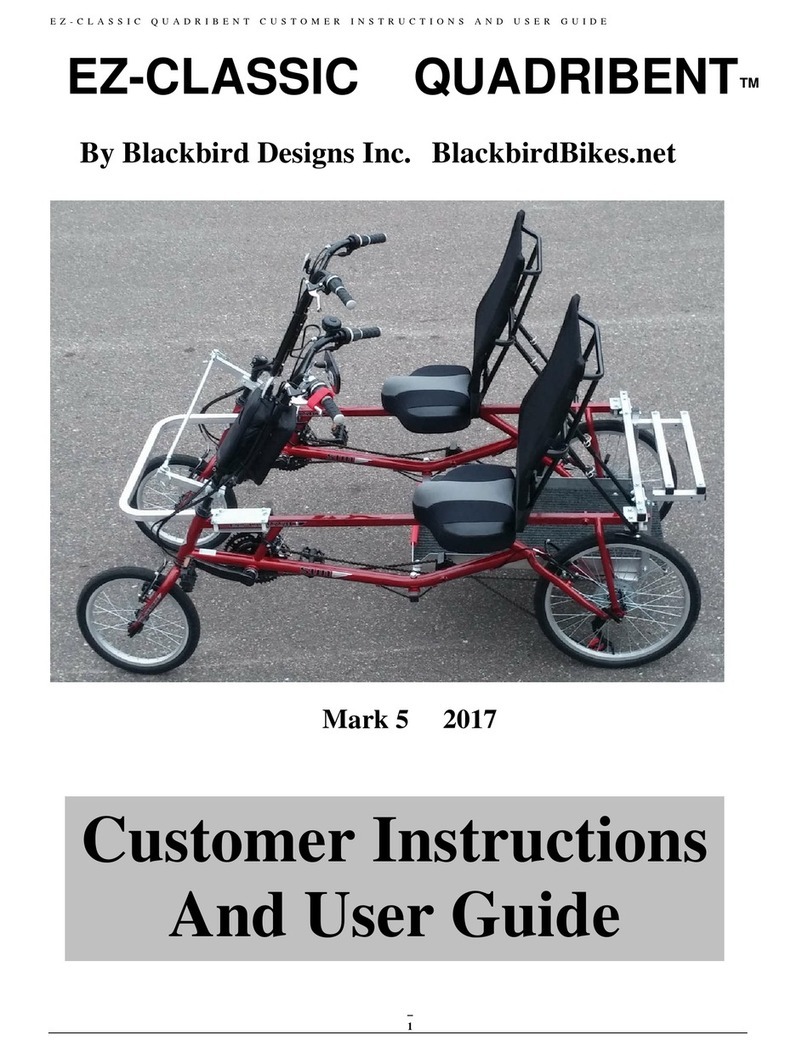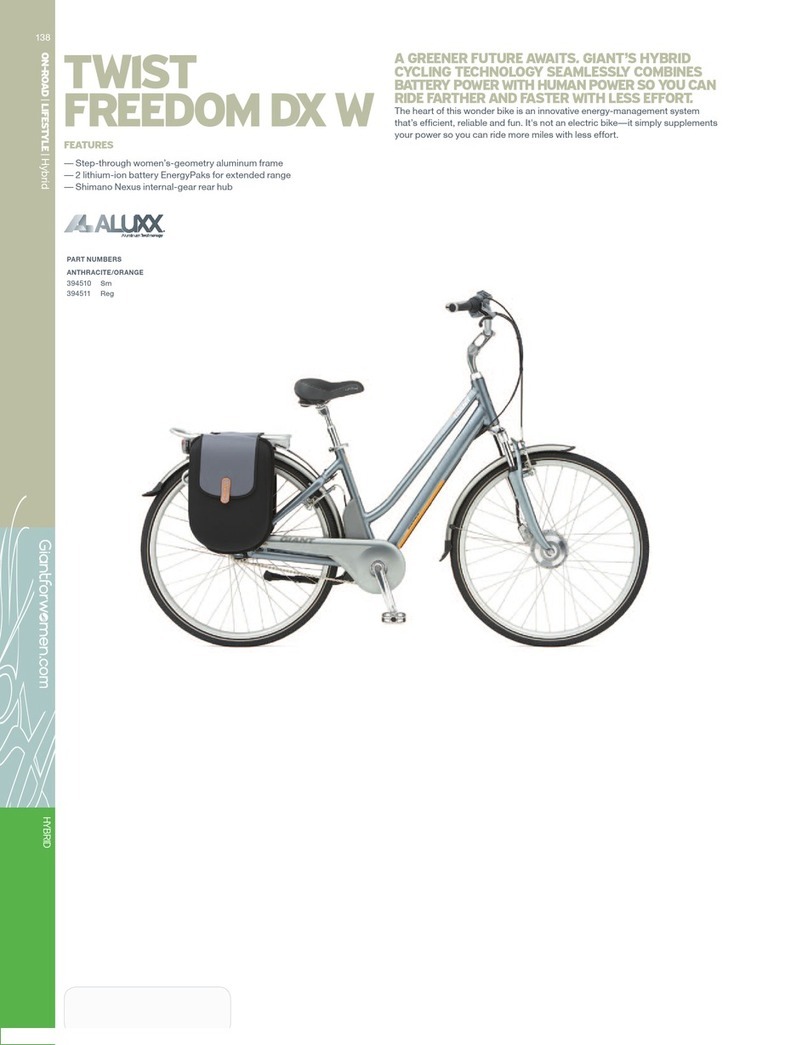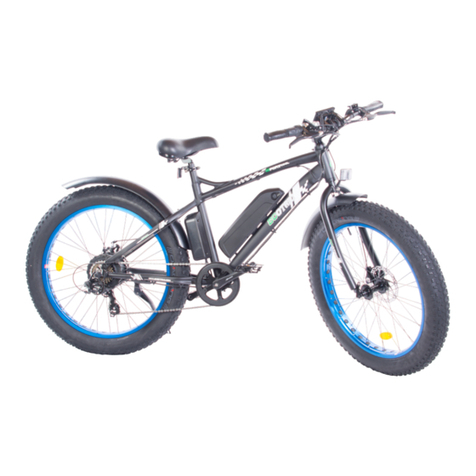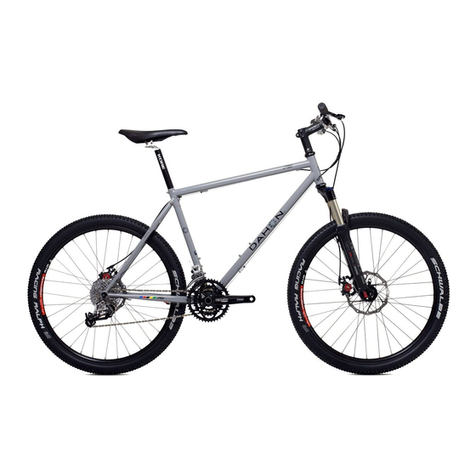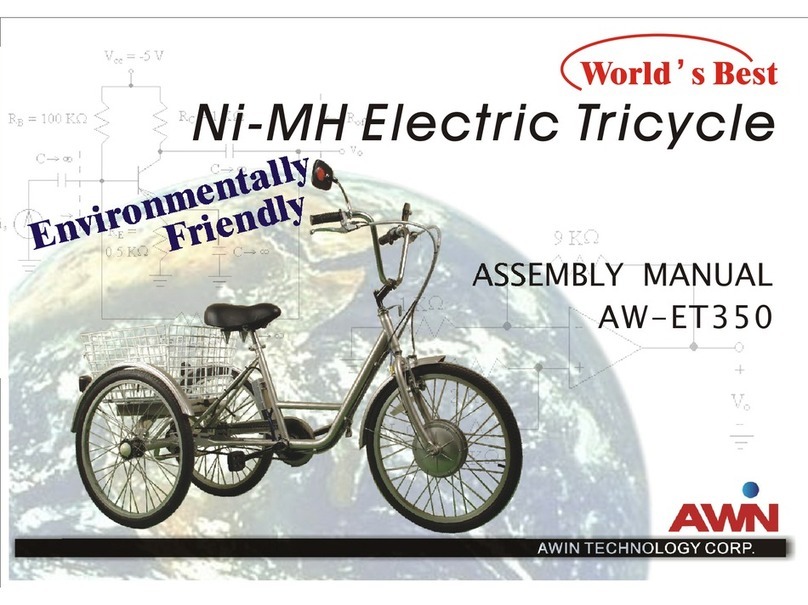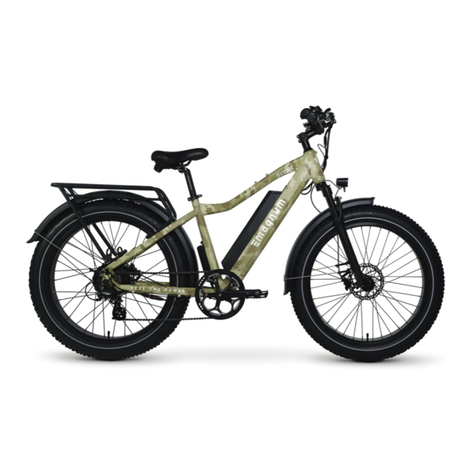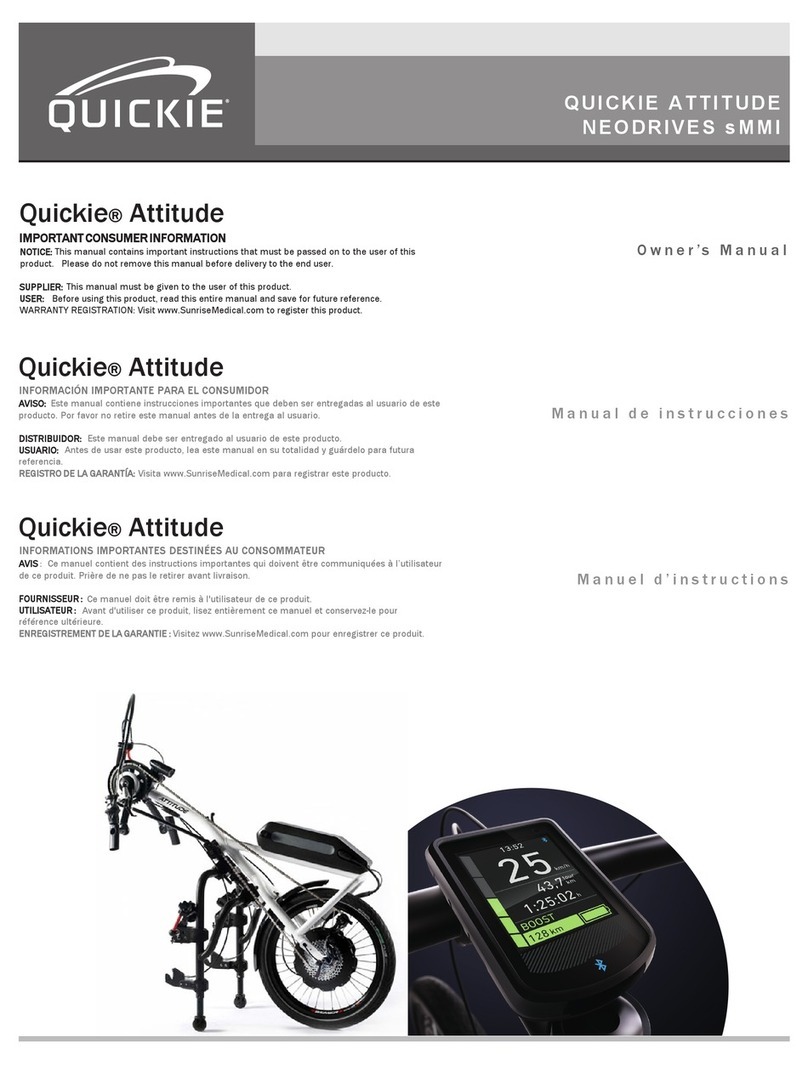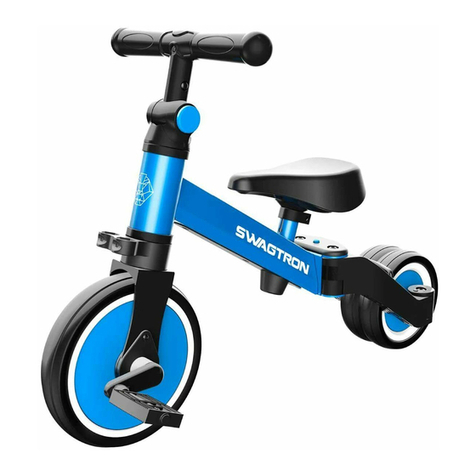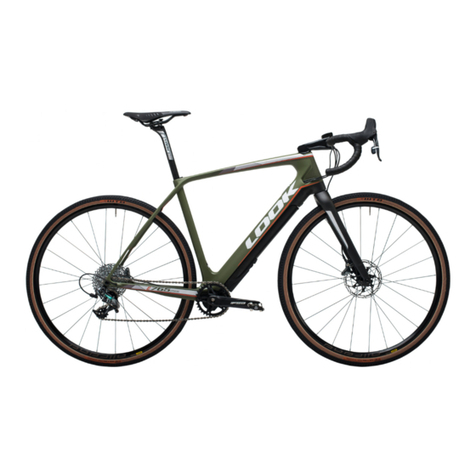Stricker Lipo Smart Series Operating instructions

Additional operating instructions
R&E Stricker Reha-Entwicklungen GmbH
Model series
Lipo Smart
Smart Wild
This supplementary instruction manual for the Lipo Smart and Smart Wild series
supplements the general instruction manual for the City, Ultra, Sport, Neodrives and
Lipo Smart series!

Manufacturer
R&E Stricker Reha-Entwicklungen GmbH
Klotzberg 64
D-77815 Bühl
Phone: +49 7223 / 72510
Fax: +49 7223 / 74947
E-Mail: [email protected]
Web: www.stricker-handbikes.de
Misprints, errors and price or product changes reserved. Product changes include, but are not limited to, changes
resulting from further development of mechanics, software or legal requirements.
Date: 2.11.2021
© R&E Stricker Reha-Entwicklungen GmbH, Bühl
Reprint, even in part, only with the written permission of R&E Stricker Reha-Entwicklungen GmbH , Bühl.
Notice to reader
For reasons of readability, the masculine form has been chosen in these operating instructions;
nevertheless, the information refers to members of all genders.

R&E Stricker Reha-Entwicklungen GmbH
1
Additional operating instructions Lipo Smart
Table of contents
1 Declaration of Conformity ..................................................................................................................2
2 Introductory notes..............................................................................................................................2
3 Note on the general instructions for use.............................................................................................2
4 Product Description & Intended Use ...................................................................................................2
5 Safety and driving instructions for accident prevention ......................................................................2
5.1 Safety instructions for battery and charger...............................................................................................3
6 Operation ...........................................................................................................................................4
6.1 Lipo Smart model series.............................................................................................................................4
6.2 Smart Wild model series.............................................................................................................................8
7 Battery and charger..........................................................................................................................12
7.1 Charging the battery................................................................................................................................. 12
7.2 Equipment................................................................................................................................................. 12
7.3 Mounting the battery................................................................................................................................ 12
7.4 Storage...................................................................................................................................................... 12
8 Repair, cleaning and maintenance ....................................................................................................12
8.1 Wheel change ........................................................................................................................................... 12
9 Transport .........................................................................................................................................13
9.1 Transportation in vehicle ......................................................................................................................... 13
10 Disposal and recycling .....................................................................................................................13
11 Warranty and guarantee ...................................................................................................................14
12 Liability ............................................................................................................................................14
Attachment ............................................................................................................................................15
A Technical data Lipo Smart....................................................................................................................... 15
B Technical data Smart Wild ...................................................................................................................... 15

2
R&E Stricker Reha-Entwicklungen GmbHAdditional operating instructions Lipo Smart
Declaration of Conformity
1 Declaration of Conformity
The device complies with the current standards and guidelines of the EU. We certify
this in the EC declaration of conformity. If required, we will be happy to send you the
corresponding declaration of conformity. Our power assist devices have been tested by
means of an electromagnetic compatibility test (EMC)..
In the event of a change not agreed with R&E Stricker GmbH, this declaration loses its validity.
2 Introductory notes
WARNING
Before operating the handcycle or power assist device, please read these operating instructions and all
other supplied operating instructions carefully and observe them.
WARNING
Visually impaired persons or persons with cognitive impairments must have the information material and
operating instructions read aloud by assistants. Corresponding documents are available on our website
www.stricker-handbikes.de on the Internet. Videos and photos are also available there.
DEALER NOTICE
It is imperative that you hand over these operating instructions to each customer when handing over the
handbike and expressly draw the customer’s attention to the safety and danger instructions.
Never deliver a handbike without operating instructions!
3 Note on the general instructions for use
WARNING
This is the supplementary instruction manual for Lipo Smart series handbikes. It supplements the general
instructions for use for the City, Ultra, Sport, Neodrives and Lipo Smart model series. It is essential that
you read both operating instructions before using the handbike.
4 Product Description & Intended Use
The handbike is coupled to a manual wheelchair as an electrically assisted manual traction aid. This
allows the rider to be supported in his mobility. The aim is to extend the range of action by enabling longer
distances to be covered more easily and independently. Coupling the handbike creates a three-wheeled
vehicle with three relatively large wheels. The handbike therefore improves driving characteristics on
uneven surfaces. Obstacles can also be overcome more easily. Driving downhill and on slopes becomes
safer due to the additional braking systems. The handbike can be independently coupled to and released
from the wheelchair by the rider. The wheelchair as such is not changed and its characteristics remain
completely unchanged.
5 Safety and driving instructions for accident prevention
WARNING
These instructions are for your own safety. Please read them carefully before using the handbike and
follow the instructions! Failure to observe the instructions for use could result in damage to the product
as well as serious personal injury. We accept no liability for damage resulting from failure to observe the
operating instructions.

R&E Stricker Reha-Entwicklungen GmbH
3
Additional operating instructions Lipo Smart
Safety and driving instructions for accident prevention
NOTE
Observe all safety and hazard information and
instructions, both in this and in all other operating
instructions supplied.
5.1 Safety instructions for battery
and charger
WARNING
Before performing any repair, cleaning or
maintenance tasks on the handbike, switch off the
electrical components and remove the batteries
from the handbike.
The batteries supplied are used exclusively to
operate the drive systems of the handbike. Do not
connect any other systems to the battery. Any use
beyond this requires the written approval of the
manufacturer. All information is state of the art at
the time of printing. Cases of misuse include:
• Use of the battery contrary to the description
and instructions in the user manual.
• Use of the battery in excess of the technical
performance limits
• Technical modication of the battery
• Modication of the battery software
• Use of the battery to supply other systems
We accept no liability for damage in the event of
misuse.
HEALTH INFORMATION
In case of contact with leaking gases, supply
fresh air. In case of body contact with battery
uids, rinse the affected body part with plenty
of water. In case of contact with mucous
membranes or discomfort, consult a physician.
5.1.1 Operation
Make sure that the batteries are rmly seated in
the holders provided and lock the batteries. This
applies especially if you have previously removed
the batteries from the power assist device for
charging.
Observe the battery temperature on the display
during extreme uphill travel. The temperature must
not exceed 45 °C. To prevent overheating, take an
operating break to relieve the batteries.
Only operate the battery in ambient temperatures
between -20 °C and 50 °C. Operation outside the
temperature range shortens the service life of the
battery and poses a risk of ignition.
Do not subject the battery to shocks. If the battery
has been dropped or has taken a knock, the battery
must be checked by the manufacturer. Contact
your dealer or the manufacturer for return and
repair/disposal procedures. This also applies to
otherwise damaged or defective batteries. Never
continue to use a damaged or defective battery. Do
not open the battery yourself.
Keep the battery dry and clean. Protect the battery
against the ingress of moisture or foreign particles.
Do not connect the battery‘s contacts to metallic
or other conductive objects. Keep the battery away
from small metallic objects such as screws, coins,
paper clips, keys or similar to avoid a short circuit.
Clean dirty contacts with a dry, clean cloth only. Do
not immerse the battery in water.
If you notice that the battery is overheating, leaking,
smoking, emitting an unusual odour or deforming,
stop using the battery immediately and switch it
off.
Protect the battery from heat and open re
(radiators, microwaves, ovens, strong sunlight).
Exposure to heat can cause ignition and explosion.
Do not open the battery casing. Do not
disassemble the battery. Damage to the battery
cells or contact with oxygen can cause re and
explosion. Opening the battery will void the
warranty.
FIRE FIGHTING
Do not attempt to extinguish lithium-ion
batteries with water or other liquids in the event
of a re. Sand is recommended by battery cell
manufacturers as the only extinguishing agent.
There is a risk of explosion in the event of a re.
Extinguish lead-gel batteries with water, foam or
CO2. Dangerous gases may be formed in a re
involving lead-gel batteries. Do not breathe in the
gases under any circumstances.
5.1.2 Charging process
WARNING
Do not leave the battery unattended during the
charging process.

4
R&E Stricker Reha-Entwicklungen GmbHAdditional operating instructions Lipo Smart
Operation
Only charge the battery at temperatures between
0 and 40 °C. A charging process outside the
temperature range is automatically aborted by the
battery. To optimize the service life, charge the
battery at temperatures of 10-30 °C.
Charge the battery in a sufciently ventilated, dry
and dust-free environment. Ensure sufcient air
circulation during the charging process.
Do not charge the battery near ammable
substances (solids, liquids, gases).
Protect the battery from moisture during the
charging process. Do not charge the battery in
rooms where water could condense on the battery
or the charger. Only use the charger when it is
completely dry. If condensation has formed, allow
the charger to dry completely before charging.
Only use the charger supplied to charge the
battery. Using any other charger may cause
malfunction, damage, defect, ignition or explosion.
Do not charge the battery with a defective charger.
Replace a defective charger immediately.
Do not use a charger that has been knocked
or dropped. Do not open or repair the charger
yourself.
Do not charge damaged batteries.
Avoid unnecessary charging and do not charge the
battery for a long time when not in use.
The battery charging process is automatically
terminated as soon as the battery is fully charged.
When charging is complete, rst disconnect the
charger from the mains socket and then from the
battery.
Do not carry the charger by the mains cable or the
charging cable. Do not pull on the mains cable to
disconnect the charger from the mains socket. Do
not subject the cables and plugs to pressure or
pinch the parts. There is a risk of electric shock or
ignition.
Position the charger so that no one can step on
or trip over the cable or charger. Also protect the
charger and all related components from other
harmful inuences or stresses.
5.1.3 Storage
Do not store the batteries in places that are
exposed to heat for long periods of time (sunlit
car boot, garden shed, etc.). The service life of
the battery depends, among other things, on the
storage conditions.
Only use your car for transport, not for storing or
keeping the battery.
For optimum service life, store the battery at
18-23 °C and a maximum humidity of 80 %. Do not
expose the battery to moisture (rain, snow, etc.)
during storage.
Charge the battery before storage according to
the specications of the respective battery. Check
the charge level at least every three months and
recharge the battery if necessary. („5.1.3 Storage“)
Ensure that the battery is stored away from
damage and unauthorised access.
Store the battery out of the reach of children.
6 Operation
WARNING
Switch off the battery when coupling or
uncoupling from the wheelchair and maneuvering
or, alternatively, turn the speed controller on the
handlebar to 0 to prevent unintentional driving off
when moving the cranks.
6.1 Lipo Smart model series
6.1.1 Start driving
NOTE
Unpacking and installation video can be found on
www.stricker-handbikes.de/installationsupport
WARNING
When parking the traction unit, always remove the
key for the key switch to prevent unauthorised use
of the unit.
Switch on the battery using the main switch on the
battery. You will know that the battery is on when
the light on the battery is on (Fig. 1)
Turn the key switch with the key to the „ON“
position . Remove the key and stow it securely so
as not to lose it while driving (Fig. 2).

R&E Stricker Reha-Entwicklungen GmbH
5
Additional operating instructions Lipo Smart
Operation
Fig. 1: Battery
Fig. 2: Lipo Smart control unit „ON“ position
6.1.2 Lipo Smart Para
On the left ergo grip you will nd the thumb
throttle for speed control above the grip surface.
Depending on the version, you can use the thumb
throttle to drive 6 or 25 km/h without cranking
assistance. If you start cranking, the thumb throttle
is deactivated. You can now set the speed using
the control on the handlebar. The handbike will
then travel at the set speed regardless of how hard
you crank.
The brake lever on the left ergo handle
automatically interrupts the electronics of the
drive when actuated. Therefore, you cannot
simultaneously operate the left brake lever and
accelerate with the thumb throttle. The brake lever
also has a locking mechanism. Use this to use the
brake as a parking brake.
The brake lever on the right ergo handle has no
breaker contact. You can use the right brake lever
to start uphill.
Always use both brake levers for braking.
6.1.3 Lipo Smart Tetra
You can adjust the speed via the control knob to
the chin control.
For easier starting, press the button of the starting
aid for one second. The handbike then supports
the starting process for two seconds with the
preset speed setting.
The Lipo Smart has a coaster brake. Activate it by
turning the cranks of the handbike backwards. The
exact function of the coaster brake is explained in
the general instructions for use in chapter.
If your Lipo Smart Tetra is equipped with thumb
throttle in addition to the speed control for chin
control, this functions according to „6.1.2 Lipo
Smart Para“.
6.1.4 Starting uphill
If you have stopped on an incline and want to start
again, you may roll backwards and not be able to
start. To be able to start despite the incline, lean
forward to put more weight on the front wheel.
Press and hold the left brake lever. Now carefully
accelerate at the same time. Reduce the pressure
on the brake as you slowly apply more throttle.

6
R&E Stricker Reha-Entwicklungen GmbHAdditional operating instructions Lipo Smart
Operation
As soon as you feel that you are moving in the
direction of travel, you can release the brake
completely.
6.1.5 Display of the charge level
You can check the battery charge level at any time
using the LED display. To do this, press the button
on the top of the battery. The charge level is also
shown on the left display.
6.1.6 End of ride
Turn the speed control knob on the handlebar to 0
to prevent unintentional driving off when moving
the cranks.
Turn the key switch with the key to the „OFF“
position . Remove the key and stow it away safely
(Fig. 3).
Turn off the battery with the main switch on the
battery. You will know the battery is off when the
light on the battery goes out.
Fig. 3: Lipo Smart control unit position „OFF
6.1.7 Optional equipment: 2 Lipo
batteries with 2 change-over
switches
This optional equipment for the Lipo Smart gives
you a towing unit with two batteries on the fork and
a control box with two linked toggle switches. The
standard battery holder on top is omitted with this
equipment.
You cannot operate the two batteries in parallel.
Use the two switches to toggle the batteries and
the display. Always switch both switches at the
same time. Make sure that both switches are in the
same position at all times.
Fig. 4: Battery left switched on

R&E Stricker Reha-Entwicklungen GmbH
7
Additional operating instructions Lipo Smart
Operation
Fig. 5: Battery right switched on
6.1.8 Special equipment: 3 Lipo
batteries with 4 switches
With this optional equipment for the Lipo Smart,
you receive a towing device with two additional
batteries on the fork and a control box with four
toggle switches.
You cannot operate the batteries in parallel. With
the two left-hand switches you switch the batteries
and the display from left to right or vice versa. Use
the two right-hand switches to switch the operation
from the standard battery to the batteries on the
fork or vice versa. Always switch two switches
at the same time. Make sure that the left or right
switches are switched to the same position at all
times.
Fig. 6: Battery on top switched on
Fig. 7: Battery bottom left switched on

8
R&E Stricker Reha-Entwicklungen GmbHAdditional operating instructions Lipo Smart
Operation
Fig. 8: Battery bottom right switched on
6.2 Smart Wild model series
6.2.1 Start driving
WARNING
Always remove the key for the key switch when
parking the handcycle to prevent unauthorized
use of the unit.Make sure the battery is properly
engaged and locked before you begin riding.
Remove the key and store it securely to prevent
the key from interfering with the chain or opening
the lock while riding. You otherwise risk loosening
the battery while driving.
Slide the battery onto the holder from above and
lock it with the key. You can check the charge level
via the charge level indicator on the battery (Fig. 9).
Fig. 9: Battery charge level indicator
Switch on the battery with the main switch on
the battery. Turn the key switch with the key to
the „ON“ position. You can remove the key of the
control unit only when it is switched off. Close the
shutter of the charging port as well as the USB port
to prevent dirt and water from getting inside. The
USB port is not intended for charging USB devices.
Please use the USB port on the display for this
purpose (Fig. 10) (Fig. 11).
Fig. 10: Switch on the battery

R&E Stricker Reha-Entwicklungen GmbH
9
Additional operating instructions Lipo Smart
Operation
Fig. 11: Key switch on battery and control
Switch on the control unit on the control panel.
The on switch with the on/off symbol is located
slightly highlighted in the center of the control unit.
You cannot remove the key when the control is
switched on. (Fig. 12).
Fig. 12: Control unit on the left handle
Press and hold the on/off switch on the control
unit for 3-5 seconds until the Stricker logo appears
on the display. The +/- keys on the control unit are
used to control the speed levels 1-5. These are
shown on the display under the speed indicator.
Press the thumb throttle to accelerate (Fig. 12)(Fig.
13).
The push assist can be activated by holding down
the „-“ key on the control unit. This causes the
handbike to move at a speed of 5km/h as long as
the key is held.
Fig. 13: Display on the handle
On the left ergo grip you will nd the thumb throttle
for speed control above the grip surface. With
the thumb throttle you can drive 6 or 25 km/h
depending on the version without assistance by
cranking. If you start cranking, the thumb throttle is
deactivated. You can regulate the support level on
the control unit. The handbike will then travel at the
set speed regardless of how hard you crank.
The current battery charge level can be read from
the upper right corner of the display. The number
next to the state of charge describes the battery
voltage in volts. (Fig. 13).
Fig. 14: Bike computer reset
You can reset the travel data by simultaneously
pressing and holding the +/- buttons on the control
unit. This will set the daily mileage and driving
time to 0 (Fig. 14).You can reset the trip data by
simultaneously pressing and holding the +/- keys
on the control unit. This will set the trip odometer
reading and the trip time to 0.If your display is

10
R&E Stricker Reha-Entwicklungen GmbHAdditional operating instructions Lipo Smart
Operation
equipped with a time, you can set it. Briey press
the M button twice in succession to access the
display settings. Select the menu item „Clock“..
Fig. 15: USB-Port on Display
The USB charging socket on the display can only
be used when the system is switched on. To do
this, remove the cover (Fig. 15).
6.2.2 Controls light/horn and optional
cruise control/reverse gear
Fig. 16: Left: Light (red) and horn (green); Right: reverse gear
(red) and cruise control (green).
To switch on the light on the handbike, press the
red button with the light symbol on the left handle.
Press the button again to turn the light off. Set the
correct angle by tilting the headlight. Press the
green button with the horn symbol to activate the
horn (Fig. 16) (Fig. 17).
Fig. 17: Adjustment of the inclination of the lamp with
integrated horn
To activate reverse gear, press the red button
on the right handle. Press the button again to
disengage reverse gear. The activated reverse gear
can be recognized by an acoustic signal (beeping)
as well as the red signal on the control unit (reverse
drive light) (Fig. 18).
Fig. 18: The reverse light on the control lights up when reverse
gear is activated
The cruise control can be activated with the green
button. When cruise control is activated, it saves
your current driving speed and retains it. Pressing
the button again will deactivate the cruise control.
Pressing the brake with breaker contact (brake
on the right handle) also deactivates the cruise
control. Should you use the throttle handle while
the cruise control is active, the handbike will not
accelerate. If the throttle grip is turned back to the
zero position after accelerating, this will deactivate
the cruise control.

R&E Stricker Reha-Entwicklungen GmbH
11
Additional operating instructions Lipo Smart
Operation
The optional cruise control can be used in
conjunction with the assist levels (1-5) to maintain
their respective maximum speed on any incline. To
do this, select level 1, for example, and accelerate
until the speed limit of the level is reached. If cruise
control is now activated, the handbike will maintain
the speed, even on inclines.
WARNING
Use cruise control only when the trafc situation
permits. Be ready to deactivate cruise control at
any time with the brake with breaker contact.
CRUISE CONTROL ON SLOPES
The cruise control only maintains the speed when
driving on the at or on inclines. The system does
NOT brake on a downhill slope.
6.2.3 Recovery brake
USAGE INSTRUCTIONS
Since the recuperation feeds energy back into
the system, some usage instructions must be
observed. If you ignore this, you run the risk of
reduced battery life and a defect in the battery.
Your product is equipped with a recuperation brake,
which feeds energy back into the battery during
braking. Recuperation is initiated by pulling the
right brake lever. Parallel to the recuperation, 2 disc
brakes are available to you (Fig. 19 ).
Fig. 19: Brake lever with brake contact and initiation of
recuperation (interrupter contact is only connected to the right
brake lever.)
The brake lever on the left side of the handlebar
has no breaker contact. You can use the left brake
lever for starting uphill („6.1.4 Starting uphill“).
The recuperation brake may only be used with a
completely intact battery. If your battery shows a
defect, such as greatly reduced capacity, greatly
changed voltage or external deformation, we
advise against further use of the battery.
NOTE ON USE
If the battery is fully charged, it cannot absorb
any regenerated energy. This means that the
function of the recuperation brake is not available
or only to a very limited extent when the battery
is fully charged. The controller may prevent
recuperation. It can happen that the recuperation
brake is suddenly switched off by the controller
while driving (e.g. during braking) because the
battery has reached its state of charge limit. This
means that you have to provide all of the braking
power via the disc brakes and therefore pull the
brake levers more strongly. For safety reasons,
we recommend that you always carry out a longer
and steeper descent with the system switched on
and the recuperation brake activated.
If you charge the device before a long and steep
downhill descent, the charging process should not
be fully completed so that the recuperation brake
works during the descent.
6.2.4 Starting uphill
If you have stopped on an incline and want to start
again, you may roll backwards and not be able to
start. To be able to start despite the slope, lean
forward to put more weight on the front wheel.
Press and hold the left brake lever. Now gently
apply the throttle at the same time. Reduce the
pressure on the brake brake as you slowly apply
more throttle. As soon as you feel that you are
moving in the direction of travel, you can release
the brake completely.
6.2.5 Battery change
Only purchase batteries for your handbike from one
of our certied Stricker dealers or directly from the
factory. Our batteries might look similar to other
e-bike batteries and might also t on the bracket.
Nevertheless, batteries might differ in technical
features that are not compatible with our system.
Please note that your warranty claim will be void if
an incompatible battery causes a defect.

12
R&E Stricker Reha-Entwicklungen GmbHAdditional operating instructions Lipo Smart
Battery and charger
7 Battery and charger
SAFETY NOTICE
Be sure to read and observe all safety and hazard
information („5.1 Safety instructions for battery
and charger“).
WARRANTY NOTICE
Batteries are wearing parts. The warranty period
is 24 months.
DISPOSAL INSTRUCTIONS
Dispose of batteries only at designated disposal
points. If you have any questions, please contact
a specialist dealer or the manufacturer.
7.1 Charging the battery
WARNING
Before using the charger, check that the mains
voltage matches the connection voltage of the
charger. The connection voltage of the charger is
indicated on its type plate.
We recommend charging the battery after each
use of the traction unit. If the battery is completely
discharged, recharge it immediately.
Charge the battery before each use. Check the
charge level of the battery before each ride. If the
battery is completely discharged while driving,
further driving is only possible manually via the
cranks.
Only switch on the battery for use. Switch the
battery off immediately when you switch off the
traction unit.
7.2 Equipment
As standard, a Lipo Smart is equipped with a
maintenance-free lithium-ion battery. Since the
battery has no memory effect, you can charge
the battery at any charge level without hesitation.
You do not need to fully discharge the battery
before charging. The battery has a fuse at a point
depending on the production date. New fuses can
be obtained from us.
7.3 Mounting the battery
The battery is attached to the frame by a bracket
and secured by a lock. You can remove the battery
from the holder for charging, changing or transport.
To do this, turn the key anti-clockwise. Slide the
battery off the holder on the side of the lock.
After xing, lock the lock again by turning the key
clockwise. Remove the key and store it safely to
prevent the lock from being opened while riding.
Fig. 20: Battery mounting
7.4 Storage
Fully charge the battery before storing it for a
longer period of time. Make sure that the battery
is switched off for storage. Check the charge level
every three months and fully recharge the battery
if necessary. Also observe the notes in („5.1.3
Storage“).
8 Repair, cleaning and
maintenance
Never use cleaning gasoline, thinner, acetone
or similar agents for any cleaning processes.
Likewise, do not use abrasive or aggressive
cleaning agents. Instead, use only commercially
available household cleaning agents and
disinfectants (isopropanol)..
8.1 Wheel change
Before you can remove the wheel of the Lipo
Smart, you must disconnect the motor cable at
the fork. To do this, you may need to unravel cable
ties. Once the motor cable is disconnected, you

R&E Stricker Reha-Entwicklungen GmbH
13
Additional operating instructions Lipo Smart
Transport
can remove the wheel. Be sure to reconnect the
connector after reinstalling the wheel. Fix the cable
again with cable ties.
Pin assignment
1 Battery display (4-pin)
2 Pedal sensor (3-pole)
3 Speed control handle (3-pole)
4 Thumb throttle (3-pin)
5 Light (4-pole)
6 Starting aid (3-pole)
Fig. 21: Pin assignment
9 Transport
NOTE
Special legal regulations apply to the transport
and shipping of lithium-ion batteries and must be
strictly observed.
The shipping of lithium-ion batteries is strictly
regulated. Therefore, take a defective battery
personally to your specialist dealer. Contact your
specialist dealer beforehand.
The legal transport regulations for taking
lithium-ion batteries with you may change annually.
Before starting a journey, enquire in good time
about the applicable regulations with the airline or
shipping company or your tour operator.
Some batteries from R&E Stricker GmbH are
suitable for air travel according to IATA guidelines
(as of 2020). The energy of these batteries is
300 Wh. The latest guidelines can be found on
our website www.stricker-handbikes.de or on the
IATA website. We recommend that you bring the
regulations with you to the airport printed out or
digitally on your smartphone or tablet. Be sure to
contact your airline when planning your trip. Not
every airline follows the IATA guidelines in their
transportation regulations. Also, depending on
the airline, it may be necessary for you to declare
the battery transport when you book your ticket
or before you start your trip. Carrying a battery
without also carrying a handcycle may be denied
by the airline. Check extensively with your airline.
WARNING
As a general rule, defective batteries must not be
taken on a ight.
9.1 Transportation in vehicle
Always transport the handbike only when it is
disconnected. If necessary, detach the attachment
stand from the handbike. Secure all individual parts
against slipping. The batteries can be transported
in any position, as they are leak-proof batteries.
Only use your car for transport, not for storing or
keeping the battery.
Airplane transportation
When transporting your handbike, for example in
the trunk of a car, never place it on the side of the
gear shift. This could damage the gearshift.
NOTE
If you take your handcycle with you on an airplane
trip, we recommend wrapping the handcycle with
packing foil (similar to cling lm). Especially the
handlebar and the frame should be well wrapped
and thus protected from scratches in the paint
and damage to mechanical parts. Alternatively,
have the handbike wrapped with stretch lm at
the airport.
10 Disposal and recycling
Electrical appliances, batteries, accessories
and packaging should be recycled in an
environmentally friendly manner.
Avoid taping parcel tape to the handcycle, as
adhesive residue is difcult to remove.
Dispose of all other components of your handcycle
according to the regulations of your region at
appropriate collection points or in the household
waste (paper, cardboard, plastic packaging).

14
R&E Stricker Reha-Entwicklungen GmbHAdditional operating instructions Lipo Smart
Warranty and guarantee
11 Warranty and guarantee
NOTE
Do not throw the batteries, chargers and electrical
components of your handbike in the household
waste. According to the current EU directives,
electrical devices and batteries must be collected
separately and recycled in an environmentally
friendly manner.
Complaints due to incomplete or incorrect delivery
or recognizable defects must be made in writing
immediately, at the latest 8 days after receipt of
the goods. Our obligation in the case of justied
complaints is limited to replacement delivery or
repair by us. In the case of warranty repairs, which
have been agreed with us in advance, the rejected
parts are to be sent back to us. Modication or
repair work carried out by the customer or a third
party without our prior consent shall invalidate the
warranty obligation.
The information on warranty and guarantee is
taken from our general terms and conditions (as
at the time of printing). These can be viewed in full
at the web address http://www.stricker-handbikes.
de/de/agb. The warranty period for the handbike is
2 years. The batteries for our Lipo and Neodrives
models also have a 2 year warranty. Not covered
by the warranty are defects that are due to
12 Liability
NOTE
The information on liability is taken from our
general terms and conditions (as at the time
of printing). These can be viewed in full at the
web address https://stricker-handbikes.de/en/
general-business-terms.
We shall only be liable for consequential damages
or other claims for damages if we, our legal
representatives or vicarious agents are guilty of
intent or gross negligence insofar as this is in
accordance with the statutory provisions.

R&E Stricker Reha-Entwicklungen GmbH
15
Additional operating instructions Lipo Smart
Liability
Attachment
A Technical data Lipo Smart
Power Assist Device
Total weight from
24,5 kg
Total weight from
21,7 kg
Transport weight* 110 cm
Height 53 cm
Width 55 cm
Length 120 kg
Maximum permissible payload 5 %
Maximum permissible cross slope 20 x
175 /47x406
Tire size
Drive 40 km
Range** Drive
Wheel hub motor electric 25
km/h
Speed Speed
control
Rated power 250 W
Operating voltage 36 V
Battery
Battery type Lithium
Ion
Rated capacity 11.6 Ah
Rated voltage 36 V
Weight 1,9 kg
Charging time ~7 h
Storage temperature range +5° to
30°
Discharge temperature range -20° to
40°
Capacity display on
battery and display
Equipment
mechanical disc brake Service
and parking brake
mechanical V-brake Service
brake
Lighting Front
light 36V LED
B Technical data Smart Wild
Power Assist Device
Total weight from 30
kg
Total weight from 26
kg
Transport weight* 110 cm
Height 53 cm
Width 55 cm
Length 120 kg
Maximum permissible payload 5 %
Maximum permissible cross slope 20 x
2.25-2.75 moped tires
16 gears (2 chainrings above, 8 sprockets below)
Tire size
Drive 50 km
(13 Ah) 65 km (17 Ah)
Range** Drive
Speed with pedelec drive 25
km/h
Maximum speed 32
km/h
Speed control thumb throttle up to 6
km/h
Rated power 1500 W
Battery
Battery type Lithium
Ion
Rated capacity 13 Ah
or 17 Ah
Rated voltage 48 V
Weight 4 kg

16
R&E Stricker Reha-Entwicklungen GmbHAdditional operating instructions Lipo Smart
Attachment
Charging time ~6,5 h
Storage temperature range +5° to 30°
Discharge temperature range -20° to 40°
Capacity display on battery and display
Equipment
mechanical disc brake service and parking brake (optional hydraulic)
Recovery brake
Lighting front light 48V LED with horn
(*) The transport weight is the total weight minus the battery and the mounting frame. It is recommended to remove
these parts for easier transport.
(**) The range varies depending on the battery used, as well as the terrain traveled and the prevailing driving
conditions. Under optimal riding conditions (for example, a level terrain, freshly charged batteries, ambient
temperature of 20 °C, steady ride, etc.), a drive power of 100 watts and a pedaling power of 100 watts, the indicated
range can be achieved.
Subject to changes in technology and design due to continuous further developments.

R&E Stricker Reha-Entwicklungen GmbH
17
Additional operating instructions Lipo Smart
Attachment

Misprints, errors and price or product changes reserved. Product changes include, but are not limited to, changes
resulting from further development of mechanics, software or legal requirements.
Date: 2.11.2021
© R&E Stricker Reha-Entwicklungen GmbH, Bühl
Reprint, even in part, only with the written permission of R&E Stricker Reha-Entwicklungen GmbH , Bühl.
V-Nr.: LS EN EC 20211102 1116
Other manuals for Lipo Smart Series
2
This manual suits for next models
1
Table of contents
Other Stricker Bicycle manuals
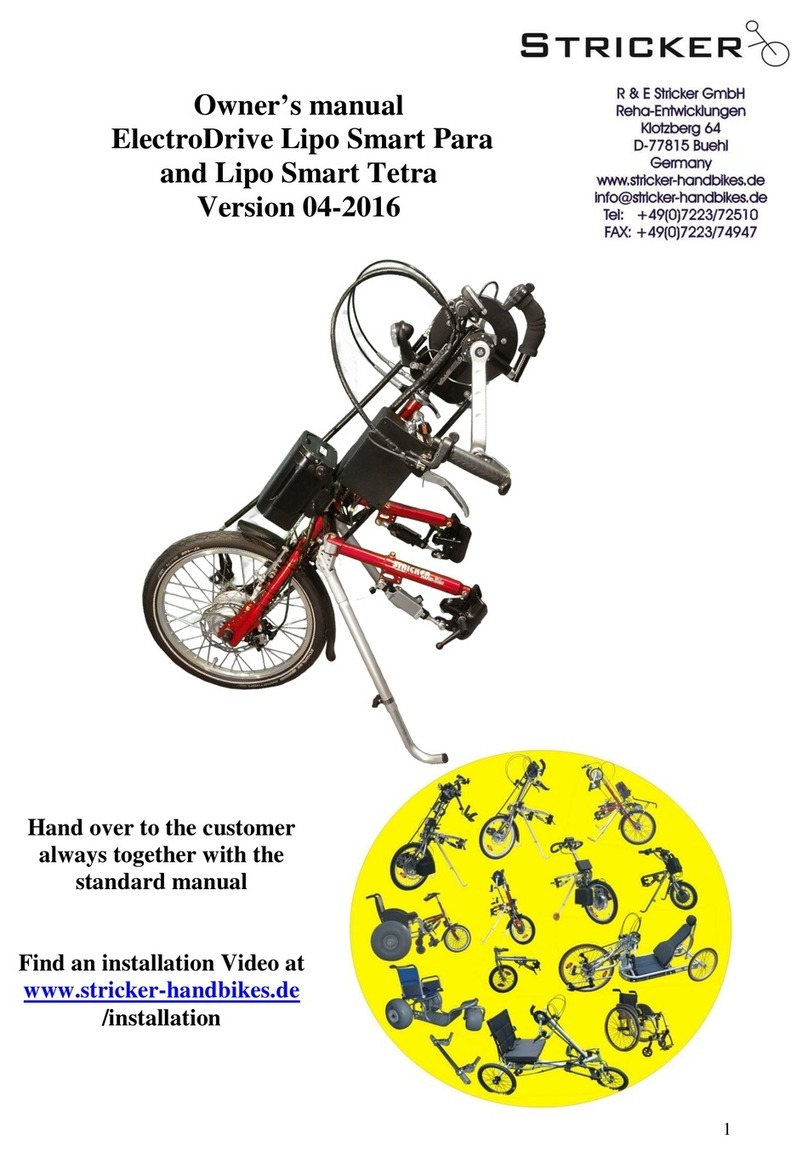
Stricker
Stricker Lipo Smart Para User manual
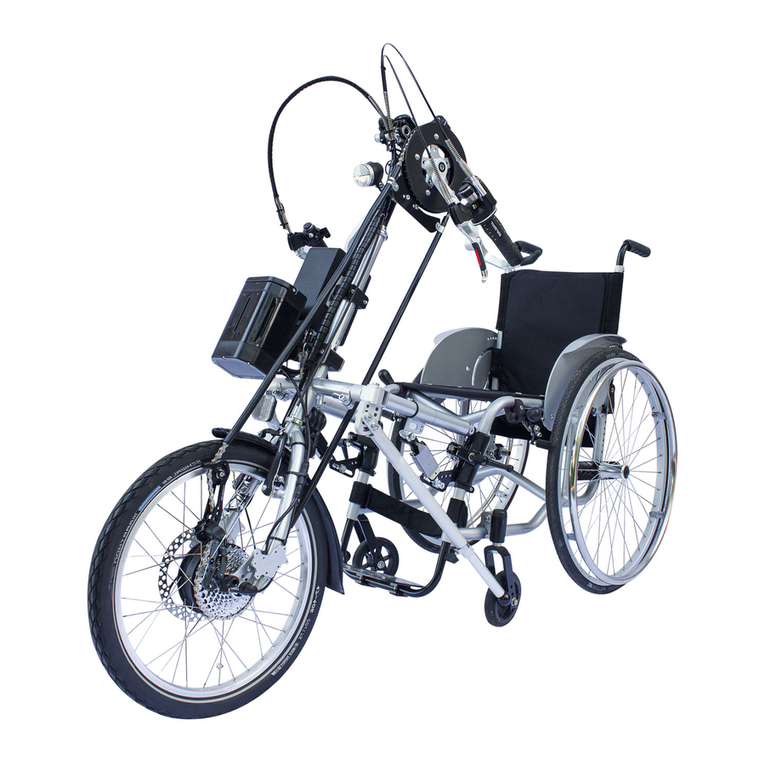
Stricker
Stricker Lipo Smart Series User manual
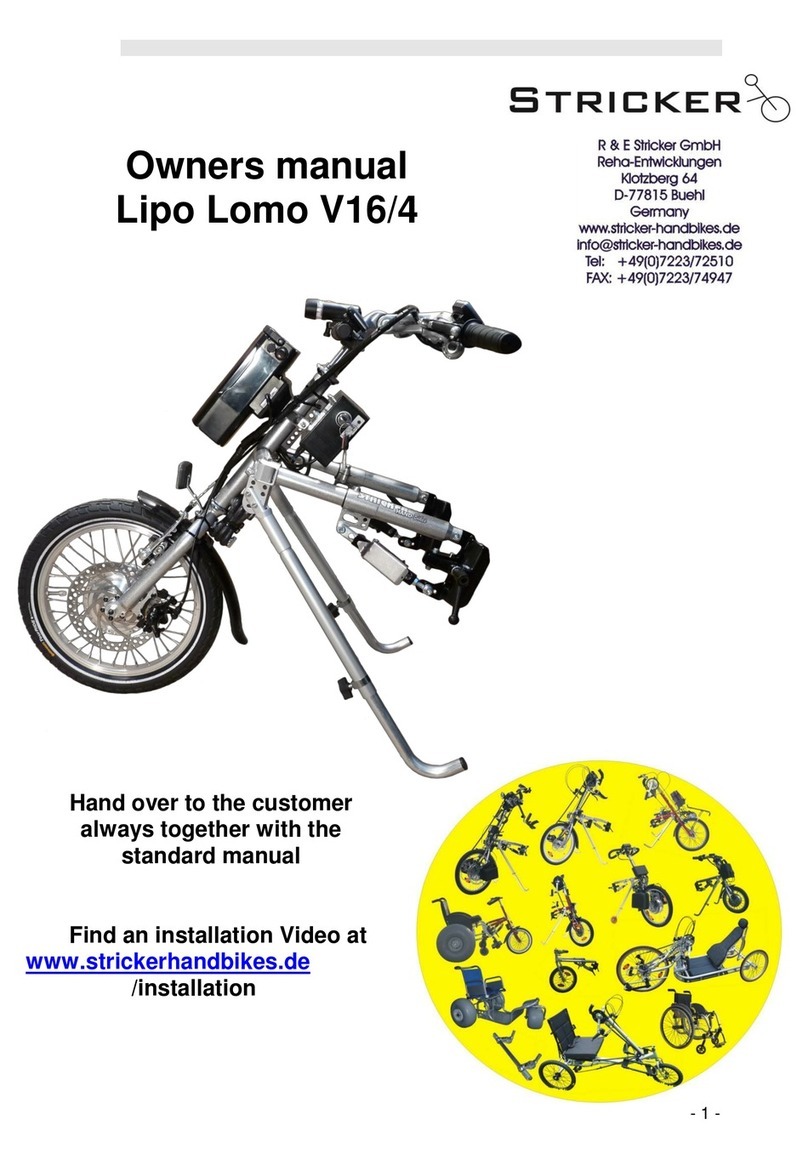
Stricker
Stricker Lipo Lomo V16/4 User manual

Stricker
Stricker City User manual
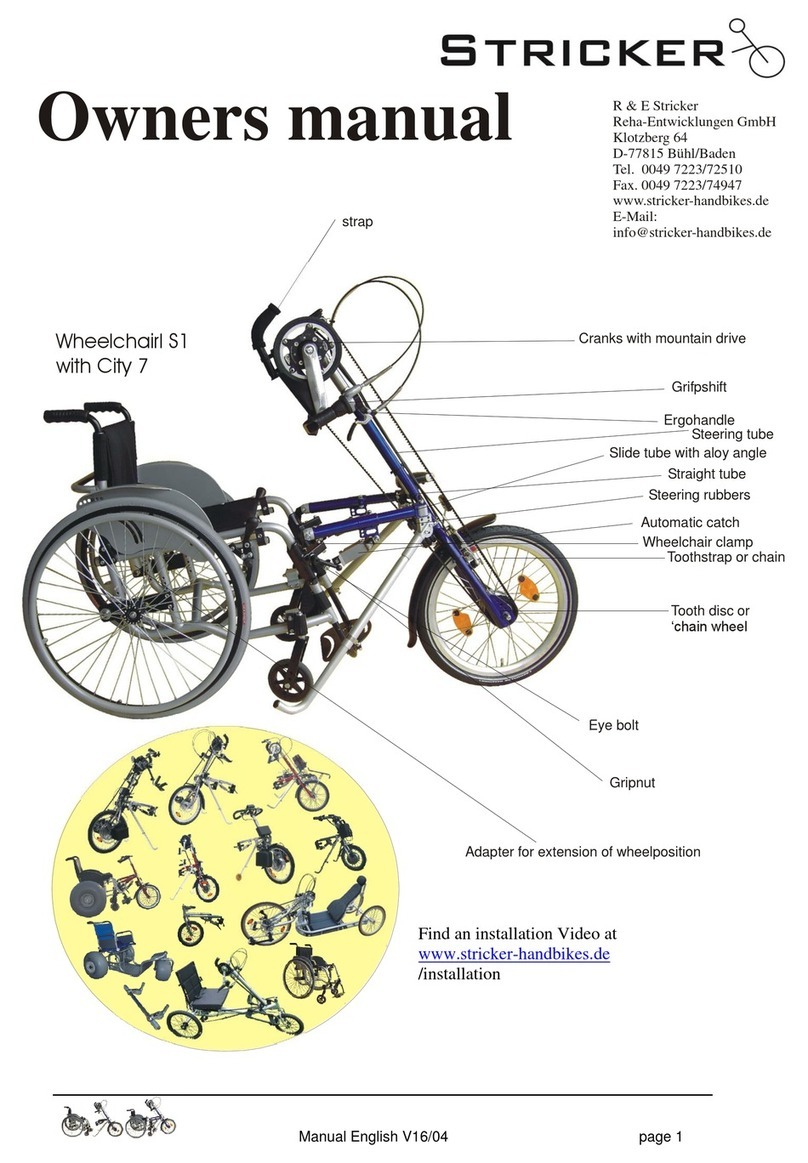
Stricker
Stricker CITY 7 User manual
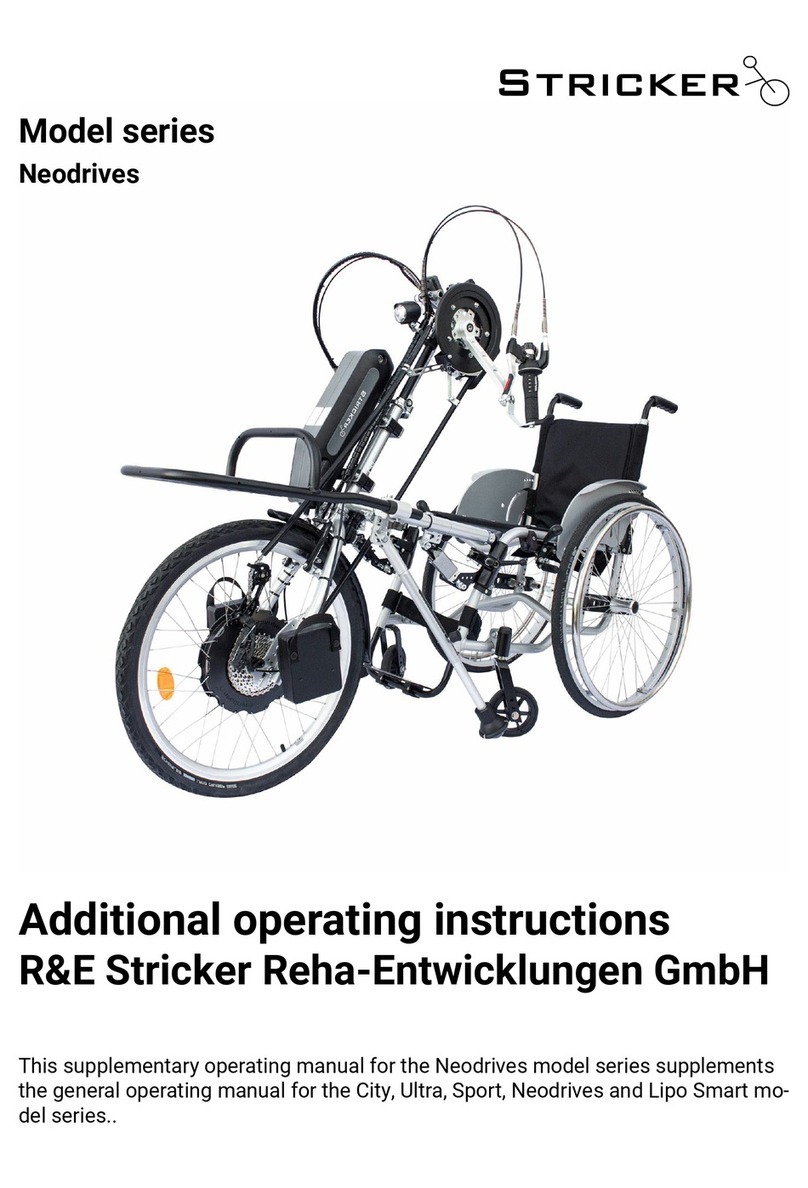
Stricker
Stricker Neodrives Operating instructions
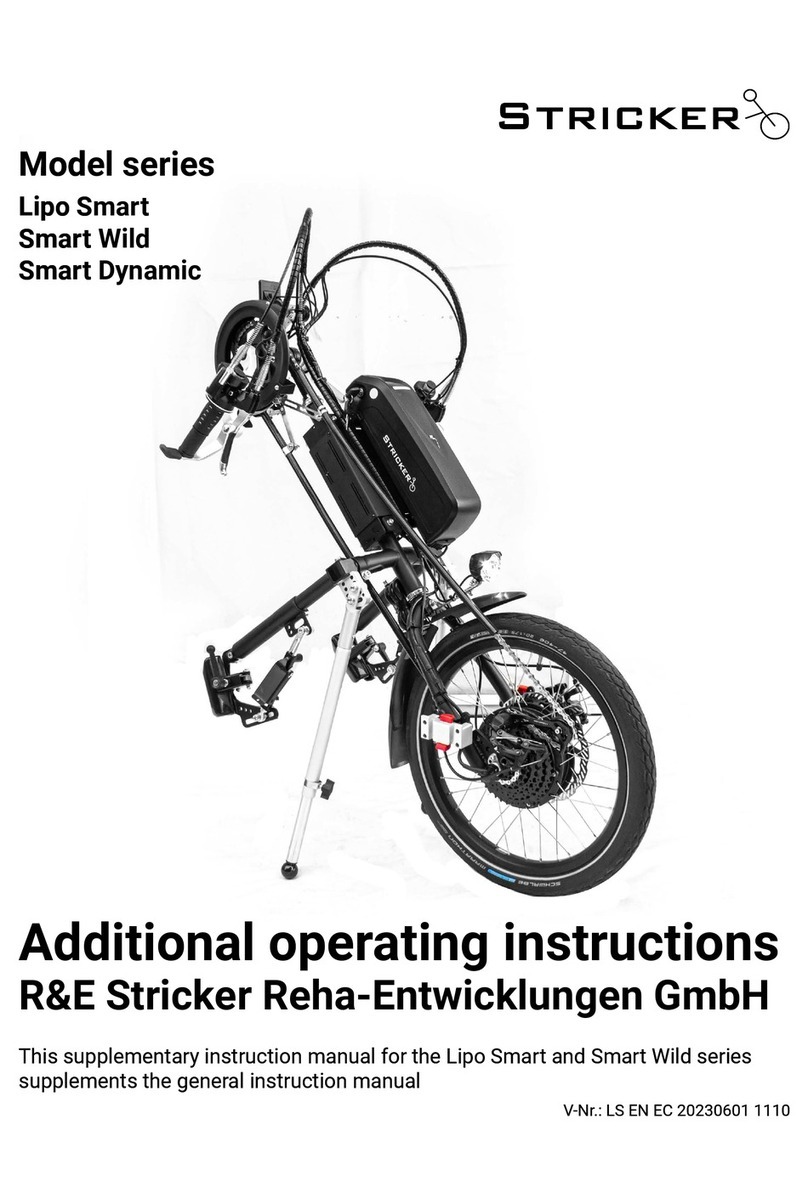
Stricker
Stricker Lipo Smart Series Operating instructions
